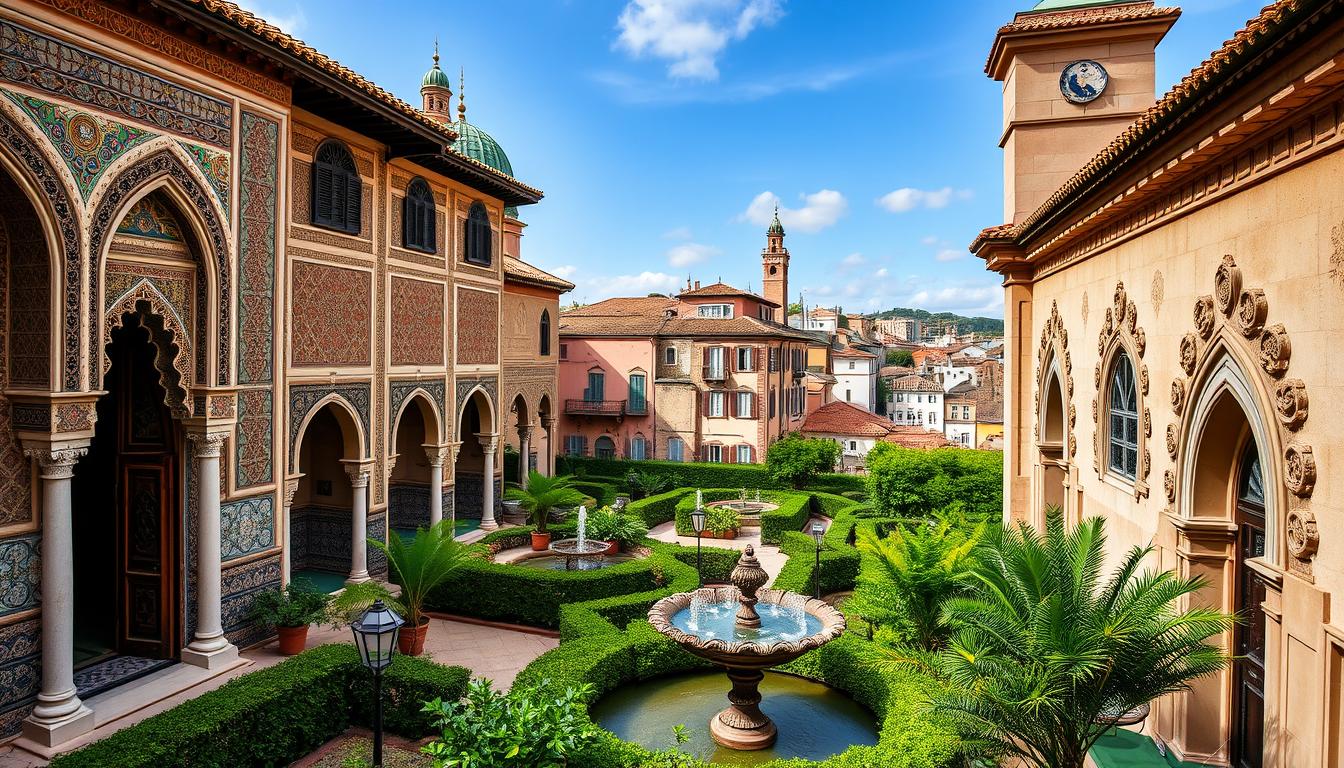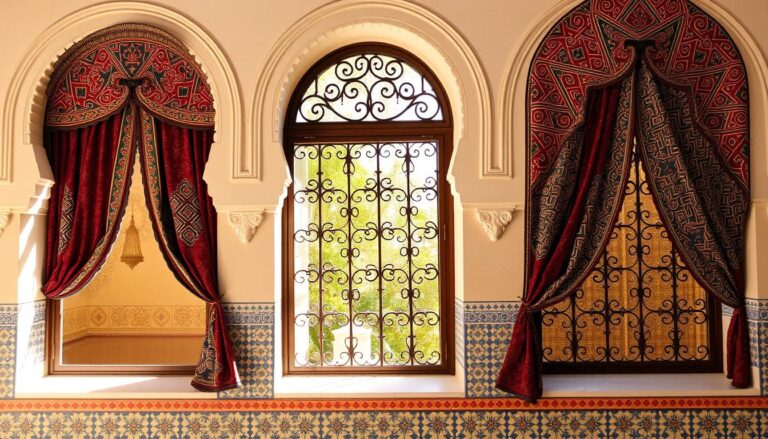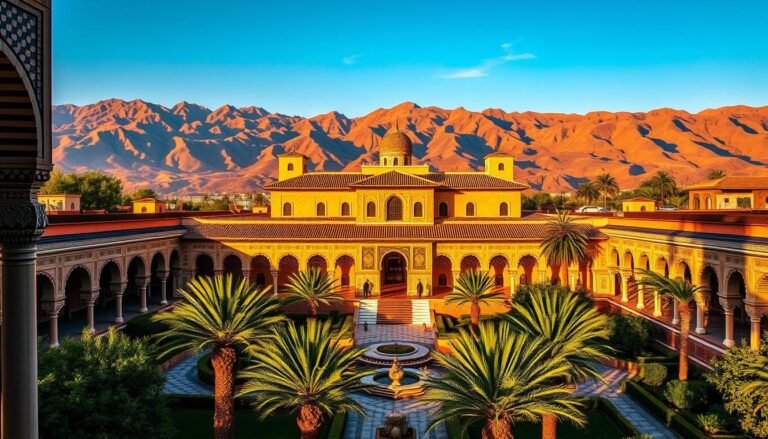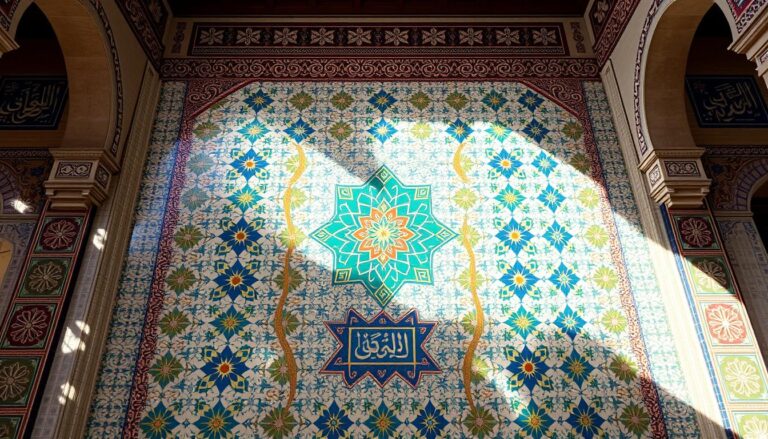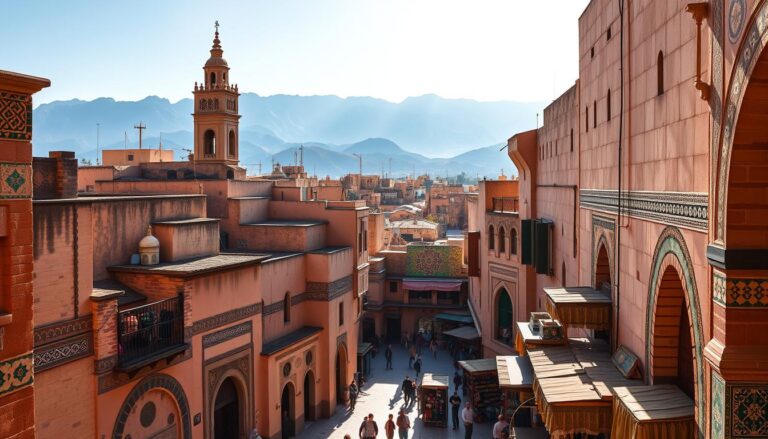Have you ever wondered how Moroccan architecture has shaped Europe? The Arabesque patterns and horseshoe arches show the Moorish influence everywhere. Let’s dive into the story of how Moroccan design became part of Europe’s buildings.
Key Takeaways
- Moorish architecture, developed in the western Islamic world, has had a lasting impact on European design.
- The Moorish style integrated influences from pre-Islamic Roman, Byzantine, and Visigothic architectures, as well as artistic currents from the Islamic Middle East and North African Berber traditions.
- Major centers of Moorish architectural development included capitals like Córdoba, Kairouan, Fes, Marrakesh, Seville, Granada, and Tlemcen.
- Even as Muslim rule ended on the Iberian Peninsula, the Moorish architectural traditions continued in North Africa and in the Mudéjar style in Spain.
- In the 19th century and after, the Moorish style was frequently imitated in the form of Neo-Moorish or Moorish Revival architecture in Europe and America.
The Origins of Moroccan Architecture
Moroccan architecture shows the country’s rich cultural mix. It has been shaped by Amazigh (Berber), Roman, and Islamic influences over the years. This mix of ancient traditions, Roman design, and Islamic art has made Morocco’s architecture unique.
Blending Amazigh, Roman, and Islamic Influences
Moroccan architecture started in the 2nd century with the Berber Kingdom. The fortified village of Ait Benhaddou in Ouarzazate is a UNESCO-listed site. It shows Amazigh architecture with its rammed earth and local designs.
Roman influences are seen in Volubilis, a 3rd-century BC Roman settlement. It has aqueducts, bath complexes, and mosaics.
The 7th century brought Islamic architecture to Morocco, thanks to Muslim Arabs. The Hassan II Mosque in Casablanca is a big example. It combines traditional Islamic designs.
By the 8th century, Moorish influences were strong in Moroccan architecture. They helped create the unique style we see today.
“Moroccan architecture reflects the country’s diverse cultural heritage, shaped by centuries of interactions between Amazigh (Berber), Roman, and Islamic influences.”
Moorish Architecture in Al-Andalus
After the Muslim conquest of the Iberian Peninsula in the early 8th century, Al-Andalus (Muslim Spain and Portugal) became a key center for Moorish architecture. The Moorish Rule in the Iberian Peninsula lasted for five centuries. The Moorish buildings in Spain are some of the only Islamic Architecture in Europe. Many see Moorish architecture in Spain as the best-preserved Islamic Architecture in Europe.
The Umayyad Caliphate crossed the Strait of Gibraltar in 711 CE and took control of the region, naming it Al-Andalus. Key monuments from this period include the Great Mosque of Cordoba, founded in 785 by the Umayyad emir Abd ar-Rahman I. The Mosque of Ibn Adabbas in Seville is also significant, being the second-oldest Muslim building in Spain after Cordoba. These early Moorish buildings show influences from ancient Classical architecture, like the reuse of columns and capitals from earlier periods.
“The Moorish architecture of Spain is considered the best-preserved Islamic Architecture in Europe.”
However, the Reconquista movement eventually pushed Moorish control back to the southern fringes of the Iberian Peninsula. This culminated in the defeat of the Emirate of Granada in 1492. The Kingdom of Castile, among other Christian Kingdoms, played a significant role in this process. They conquered important Islamic strongholds like Toledo, Valencia, and Seville.
Moorish architecture in Spain is known for unique structural components, such as the horseshoe arch. It also features intricate details and complex geometric patterns. Some of the best examples include the Alhambra in Granada, the Mezquita in Córdoba, the Castle of Gormaz in Castile and León, and the Giralda in Seville.
The Almoravid and Almohad Dynasties: Defining Moorish Style
The fall of the Cordoban caliphate in the early 11th century was a big change for Moroccan and Moorish architecture. This time saw the rise of two key Berber empires: the Almoravids (11th-12th centuries) and the Almohads (12th-13th centuries). These dynasties were crucial in creating the Moorish architectural style that would shape the area for many years.
Iconic Moroccan Architecture from the 11th-13th Centuries
The Almoravids brought new ornamental techniques to their buildings, adding depth and complexity. The Almohads, meanwhile, built the imperial capitals of Marrakesh and Rabat. They also built famous landmarks like the Kutubiyya Mosque and the Hassan Tower. Their architecture, including the Alhambra in Granada, Spain, had a lasting effect.
“The Almoravid and Almohad periods are considered one of the most formative stages of Moroccan and Moorish architecture, establishing many of the forms and motifs that were refined in subsequent centuries.”
Today, we can still see the impact of these dynasties in the region. The Moorish architectural style remains a wonder to visitors and scholars. Their buildings, with intricate patterns and grand scale, left a lasting mark on North Africa and beyond.
Moroccan architecture in Europe
When Muslim rule ended in the Iberian Peninsula, Moorish architecture thrived in North Africa. It also influenced the Mudéjar style in Spain. This style mixed Moorish designs with Christian tastes. In the 19th century, the Moorish style became popular again in Europe and America.
In many European cities, you can see the Moorish influence. It’s in mosques, palaces, and homes. The Neo-Moorish style is known for its intricate patterns, tilework, and arches. It created a unique look that people loved.
The Mudejar architecture in Spain is a mix of Islamic and Christian styles. Places like Córdoba and Granada show this blend. The Mosque-Cathedral of Córdoba and the Alhambra palace are famous examples.
“The Moorish style was frequently imitated in the form of Neo-Moorish or Moorish Revival architecture in Europe and America, including Neo-Mudéjar in Spain. This Moorish-inspired architecture can be seen in many European cities, demonstrating the lasting impact of Moroccan and Islamic design on the continent.”
The love for Moroccan architectural influence in Europe, Moorish revival architecture, Neo-Moorish style, and Mudejar architecture shows a long history of cultural exchange. It highlights the architectural sharing between North Africa and Europe.
Conclusion
Moroccan architecture has left a lasting impact in Europe. Its rich cultural exchange and preservation have made a big mark. From Spain’s Moorish buildings to the Moorish Revival styles of the 19th and 20th centuries, Moroccan design has shown its adaptability and lasting appeal.
The Iberian Peninsula is a great example of Moroccan architecture’s influence. It combines Amazigh, Roman, and Islamic styles. Geometric motifs, floral patterns, and calligraphy are key features. Techniques like horseshoe arches and muqarnas vaults are also widely used.
As we value Moroccan architecture’s cultural and artistic heritage, preserving these structures is crucial. This work protects the past and keeps Moroccan design’s legacy alive. It inspires architects and designers for years to come.
Source Links
- Architecture from Morocco | ArchDaily
- Majestic Moroccan Architecture In 10 Buildings
- From Islamic to Art Deco: A rich history of Moroccan architecture
- Moroccan architecture
- The Top 20 Examples – Architecture of Cities
- Where to See the Best Moorish Architecture in Spain?
- Moorish architecture
- Islamic arts – Moorish, Architecture, Decoration | Britannica
- Moroccan Architecture: In-Depth Review of Styles in Morocco
- A Dialogue in Art and Architecture: Morocco and Spain | IES Abroad
- These 8 architectural masterpieces in Morocco will blow you away
- Arab architecture in Spain and Portugal – Alubuild
- Heritage of Modern Architecture in Morocco

The Editorial Team is a passionate group of Morocco enthusiasts dedicated to sharing the beauty, culture, and wonders of this captivating country. With diverse backgrounds and a deep love for travel, we strive to bring you engaging and informative content that inspires your Moroccan adventures. From uncovering hidden gems and sharing local insights to exploring mouthwatering cuisine and showcasing the vibrant lifestyle, our team is committed to providing you with valuable resources and exciting stories that enhance your exploration of Morocco. Join us on this journey as we celebrate the rich heritage and unforgettable experiences that make Morocco truly special.

